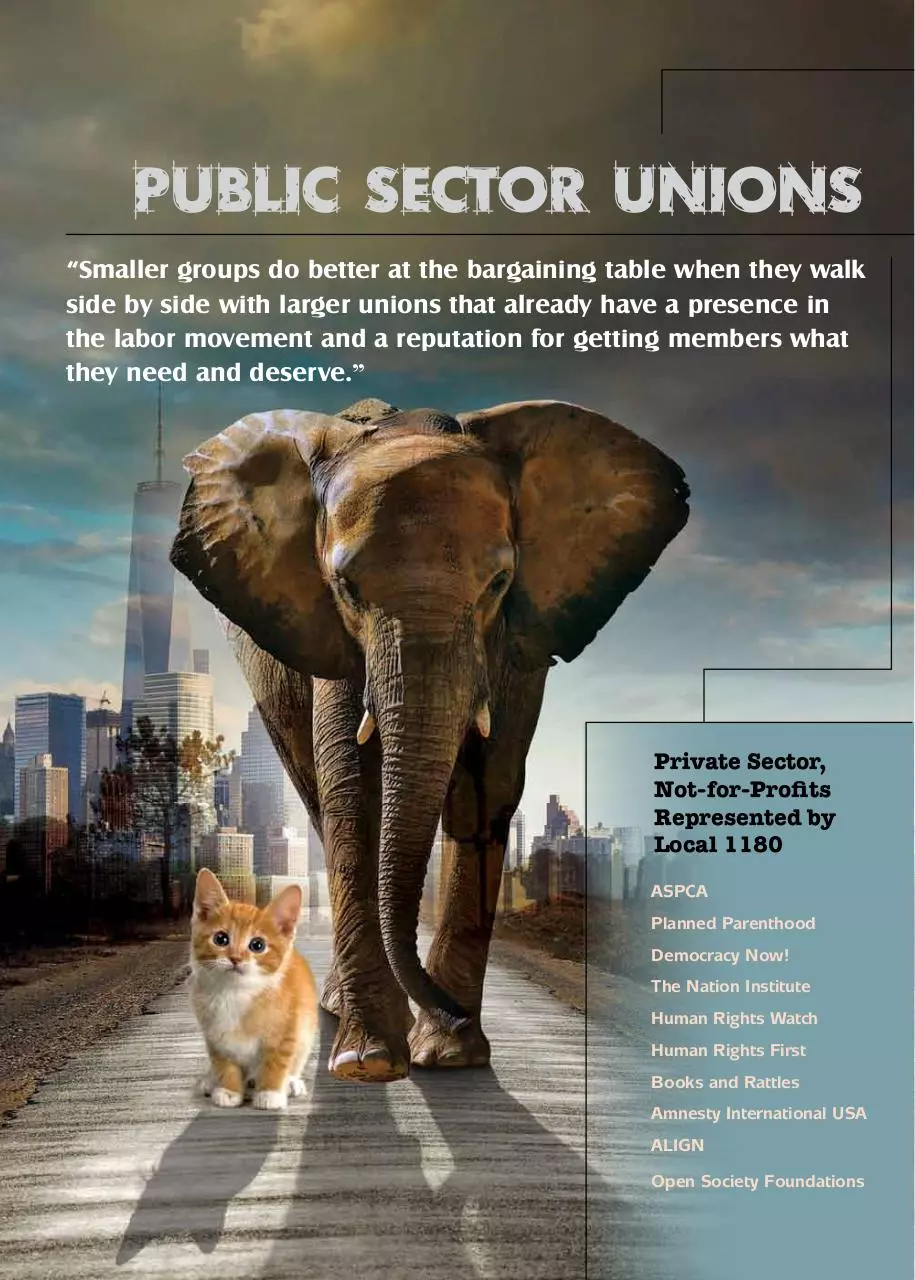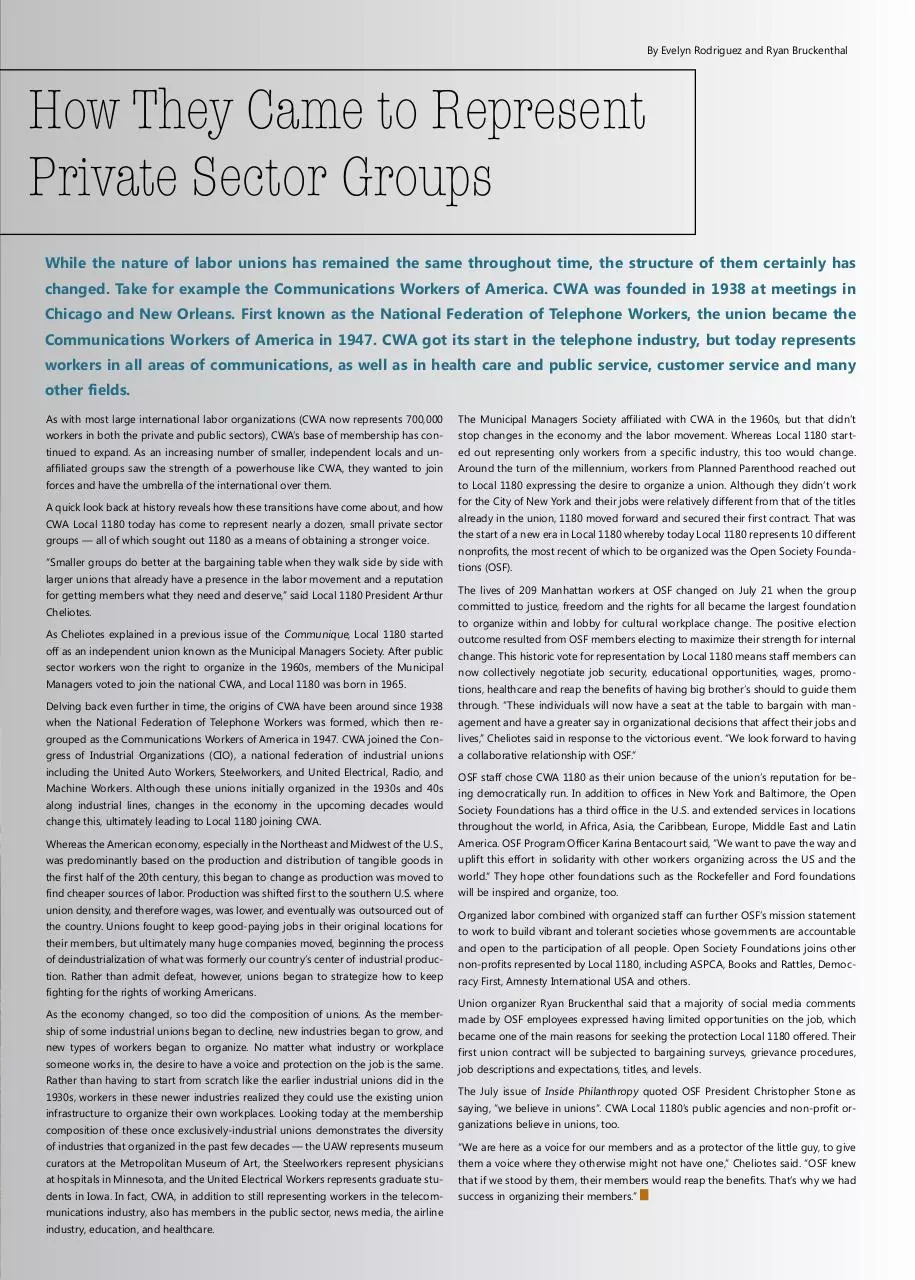How Public Sector Unions (PDF)
File information
This PDF 1.5 document has been generated by Adobe InDesign CS5 (7.0.4) / Adobe PDF Library 9.9, and has been sent on pdf-archive.com on 28/02/2017 at 22:57, from IP address 100.38.x.x.
The current document download page has been viewed 287 times.
File size: 674.31 KB (2 pages).
Privacy: public file


File preview
Public Sector UnionS
“Smaller groups do better at the bargaining table when they walk
side by side with larger unions that already have a presence in
the labor movement and a reputation for getting members what
they need and deserve.”
Private Sector,
Not-for-Profits
Represented by
Local 1180
ASPCA
Planned Parenthood
Democracy Now!
The Nation Institute
Human Rights Watch
Communique I 10
Human Rights First
Books and Rattles
Amnesty International USA
ALIGN
Open Society Foundations
*Hypothetical Local 1180 members
By Evelyn Rodriguez and Ryan Bruckenthal
How They Came to Represent
Private Sector Groups
While the nature of labor unions has remained the same throughout time, the structure of them certainly has
changed. Take for example the Communications Workers of America. CWA was founded in 1938 at meetings in
Chicago and New Orleans. First known as the National Federation of Telephone Workers, the union became the
Communications Workers of America in 1947. CWA got its start in the telephone industry, but today represents
workers in all areas of communications, as well as in health care and public service, customer service and many
other fields.
As with most large international labor organizations (CWA now represents 700,000
The Municipal Managers Society affiliated with CWA in the 1960s, but that didn’t
workers in both the private and public sectors), CWA’s base of membership has con-
stop changes in the economy and the labor movement. Whereas Local 1180 start-
tinued to expand. As an increasing number of smaller, independent locals and un-
ed out representing only workers from a specific industry, this too would change.
affiliated groups saw the strength of a powerhouse like CWA, they wanted to join
Around the turn of the millennium, workers from Planned Parenthood reached out
forces and have the umbrella of the international over them.
to Local 1180 expressing the desire to organize a union. Although they didn’t work
A quick look back at history reveals how these transitions have come about, and how
CWA Local 1180 today has come to represent nearly a dozen, small private sector
groups — all of which sought out 1180 as a means of obtaining a stronger voice.
“Smaller groups do better at the bargaining table when they walk side by side with
larger unions that already have a presence in the labor movement and a reputation
for getting members what they need and deserve,” said Local 1180 President Arthur
Cheliotes.
As Cheliotes explained in a previous issue of the Communique, Local 1180 started
off as an independent union known as the Municipal Managers Society. After public
sector workers won the right to organize in the 1960s, members of the Municipal
Managers voted to join the national CWA, and Local 1180 was born in 1965.
for the City of New York and their jobs were relatively different from that of the titles
already in the union, 1180 moved forward and secured their first contract. That was
the start of a new era in Local 1180 whereby today Local 1180 represents 10 different
nonprofits, the most recent of which to be organized was the Open Society Foundations (OSF).
The lives of 209 Manhattan workers at OSF changed on July 21 when the group
committed to justice, freedom and the rights for all became the largest foundation
to organize within and lobby for cultural workplace change. The positive election
outcome resulted from OSF members electing to maximize their strength for internal
change. This historic vote for representation by Local 1180 means staff members can
now collectively negotiate job security, educational opportunities, wages, promotions, healthcare and reap the benefits of having big brother’s should to guide them
Delving back even further in time, the origins of CWA have been around since 1938
through. “These individuals will now have a seat at the table to bargain with man-
when the National Federation of Telephone Workers was formed, which then re-
agement and have a greater say in organizational decisions that affect their jobs and
grouped as the Communications Workers of America in 1947. CWA joined the Con-
lives,” Cheliotes said in response to the victorious event. “We look forward to having
gress of Industrial Organizations (CIO), a national federation of industrial unions
a collaborative relationship with OSF.”
including the United Auto Workers, Steelworkers, and United Electrical, Radio, and
OSF staff chose CWA 1180 as their union because of the union’s reputation for be-
Machine Workers. Although these unions initially organized in the 1930s and 40s
along industrial lines, changes in the economy in the upcoming decades would
change this, ultimately leading to Local 1180 joining CWA.
ing democratically run. In addition to offices in New York and Baltimore, the Open
Society Foundations has a third office in the U.S. and extended services in locations
throughout the world, in Africa, Asia, the Caribbean, Europe, Middle East and Latin
Whereas the American economy, especially in the Northeast and Midwest of the U.S.,
America. OSF Program Officer Karina Bentacourt said, “We want to pave the way and
was predominantly based on the production and distribution of tangible goods in
uplift this effort in solidarity with other workers organizing across the US and the
the first half of the 20th century, this began to change as production was moved to
world.“ They hope other foundations such as the Rockefeller and Ford foundations
find cheaper sources of labor. Production was shifted first to the southern U.S. where
will be inspired and organize, too.
union density, and therefore wages, was lower, and eventually was outsourced out of
Organized labor combined with organized staff can further OSF’s mission statement
the country. Unions fought to keep good-paying jobs in their original locations for
their members, but ultimately many huge companies moved, beginning the process
of deindustrialization of what was formerly our country’s center of industrial production. Rather than admit defeat, however, unions began to strategize how to keep
fighting for the rights of working Americans.
As the economy changed, so too did the composition of unions. As the membership of some industrial unions began to decline, new industries began to grow, and
new types of workers began to organize. No matter what industry or workplace
someone works in, the desire to have a voice and protection on the job is the same.
Rather than having to start from scratch like the earlier industrial unions did in the
1930s, workers in these newer industries realized they could use the existing union
infrastructure to organize their own workplaces. Looking today at the membership
composition of these once exclusively-industrial unions demonstrates the diversity
to work to build vibrant and tolerant societies whose governments are accountable
and open to the participation of all people. Open Society Foundations joins other
non-profits represented by Local 1180, including ASPCA, Books and Rattles, Democracy First, Amnesty International USA and others.
Union organizer Ryan Bruckenthal said that a majority of social media comments
made by OSF employees expressed having limited opportunities on the job, which
became one of the main reasons for seeking the protection Local 1180 offered. Their
first union contract will be subjected to bargaining surveys, grievance procedures,
job descriptions and expectations, titles, and levels.
The July issue of Inside Philanthropy quoted OSF President Christopher Stone as
saying, “we believe in unions”. CWA Local 1180’s public agencies and non-profit organizations believe in unions, too.
of industries that organized in the past few decades — the UAW represents museum
“We are here as a voice for our members and as a protector of the little guy, to give
curators at the Metropolitan Museum of Art, the Steelworkers represent physicians
them a voice where they otherwise might not have one,” Cheliotes said. “OSF knew
at hospitals in Minnesota, and the United Electrical Workers represents graduate stu-
that if we stood by them, their members would reap the benefits. That’s why we had
success in organizing their members.” g
dents in Iowa. In fact, CWA, in addition to still representing workers in the telecommunications industry, also has members in the public sector, news media, the airline
industry, education, and healthcare.
Download How Public Sector Unions
How Public Sector Unions.pdf (PDF, 674.31 KB)
Download PDF
Share this file on social networks
Link to this page
Permanent link
Use the permanent link to the download page to share your document on Facebook, Twitter, LinkedIn, or directly with a contact by e-Mail, Messenger, Whatsapp, Line..
Short link
Use the short link to share your document on Twitter or by text message (SMS)
HTML Code
Copy the following HTML code to share your document on a Website or Blog
QR Code to this page

This file has been shared publicly by a user of PDF Archive.
Document ID: 0000561867.